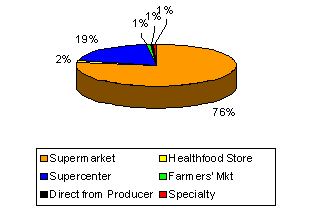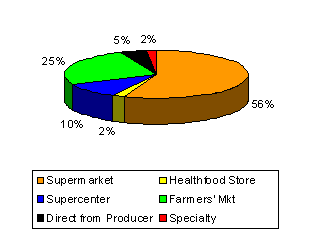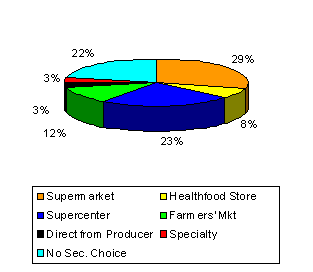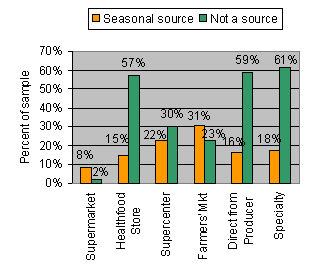Direct marketing via farmers' markets, roadside stands, community supported agriculture (CSA) programs, and other outlets, is integral to the prosperity of many small fruit and vegetable farms. 1 Through direct marketing, producers are able to establish a closer relationship with consumers, avoid expenses associated with using a broker or wholesaler, and increase their profits (USDA-AMS, 2002a). Moreover, direct marketing may be one of the most effective marketing system strategies to address emerging demand for more local food systems (Pirog, 2004).
American consumption trends may be contributing to growth in produce-related direct marketing channels. According to the 2004 USDA Vegetables and Melons Situation and Outlook, U.S. per capita consumption of fresh vegetables and melons increased by 52.6% between 1979 and 2004. Increased demand may have consumers seeking out new sources, including direct marketing channels, to satisfy their desire for fresh produce. Furthermore, a significant number of consumers have expressed a willingness to pay a premium for environmentally friendly (e.g., organic) and locally produced products, both of which are common offerings at many farmers markets and CSA programs (Wimberley et al., 2003).
In addition to farmers' markets, producers may choose to develop their own marketing enterprises, including "pick-your-own" farms and on-farm produce stands, as a way to capture consumers who may drive by or be seeking an on-farm experience. Other programs, like the aforementioned CSAs, allow producers to spread production risk over a number of shareholders by selling shares of the farm production prior to the growing season. As such, direct marketing strategies may play a role in supporting the financial prosperity of small- and medium-sized farms.
This article contributes to the understanding of direct produce marketing by reporting some key results from a national survey that collected data on consumers' fresh produce purchasing habits, with a particular emphasis on those consumers who purchase directly from producers. In particular, we discuss the differences in motivations when selecting fresh produce purchase locations, and compare attribute preferences between direct purchasers and consumers who do not use these channels. With this analysis, we compare how consumers who buy directly from producers differ from other consumers in terms of fresh produce purchasing habits and which attributes are most valued by different consumer groups.
The Consumer Survey
Consumer data concerning purchasing habits, production practice, and product attributes were collected from a national online survey conducted in May 2006. A total of 3,170 members of the National Family Opinion Organization's online survey database were solicited to take the survey, with 1,549 returned (a response rate of 48.86%). The sample is representative of the United States population in terms of income, household size, and the percent of households with children living at home (USDC Bureau of the Census, 2000); however, Hispanics are underrepresented as is the case in many consumer surveys. The fact that our respondents are predominantly female is similar to findings in several contemporary food and grocery-oriented surveys which determined that females are most likely to be the primary grocery shoppers in a household.2 Primary grocery shoppers were asked about their general food and fresh produce purchase location preferences, including primary, secondary, and seasonal sources, in addition to those not frequented over the last twelve months. Respondents were also asked to rate how important various motivations were to them when selecting where they purchased produce and an additional question asked how important numerous production practices and product attributes were to consumers when making purchase decisions.
Consumer Grocery and Fresh Produce Shopping Behavior
Survey respondents were asked to identify where they preferred to purchase food in general and fresh produce in particular. Figures 1 and 2 indicate the breakdown of consumers' preferred primary food and fresh produce purchase locations, respectively. Unsurprisingly, for food in general, the majority of respondents (76%) prefer to make primary purchases at the supermarket and another 19% prefer supercenters (e.g., Costco, Sam's Club). Healthfood stores are preferred by just 2% of the group, while direct from producer venues and specialty stores are the preferred primary food purchase locations for only 3% of the survey population. The findings are consistent with expectations that supermarkets are the preferred food purchase location for the majority of shoppers, while other outlets comprise a minority.
Restricting attention to sources of fresh produce (Figure 2), the percentage of consumers who prefer supermarkets as their primary source declines to 56%. Thus, it appears that, through product offerings or locational attributes, alternative outlets provide features that make them a relatively more appealing venue for produce purchases over general food purchases. The share associated with farmers' markets and direct from producer channels constitutes a collective 30% of respondents, while just 10% prefer to purchase fresh produce primarily from supercenters and 2% prefer to purchase fresh produce primarily from specialty and healthfood stores.
Consumers were also asked to indicate their preferences for secondary sources of fresh produce (Figure 3).3 While 22% of the sample had no preferred secondary source of fresh produce, 52% indicated supermarkets or supercenters as a complement to their primary source, and 15% selected farmers' markets or direct-from-producer channels. Relative to primary produce sources, this sample expresses greater diversity in consumers' secondary purchase location preferences. This may be a function of consumers' willingness to "shop around" or make a special trip for specific items, such as ethnic vegetables like kohlrabi or organic herbs that may not be available at their primary produce or general food purchase location.
Just as supplies of local produce in most areas of the country are likely to be seasonal in nature, many farmers' markets and some direct from producer channels are accessible only during certain times of the year (USDA-AMS, 2002a). To capture seasonal preferences, we asked consumers to indicate which locations they preferred to use as a source of seasonal fresh produce, as well as those sources that were not used in the past twelve months (Figure 4).4 About 30% of respondents indicated a preference for farmers' markets as a seasonal source of produce, followed by about 22% who preferred supercenters. Specialty stores (17.6%), direct from producer channels (16.1%), healthfood stores (15%), and supermarkets (8.3%) follow in order of preference. Just 22.7% and 2%, respectively, indicated they did not purchase fresh produce at farmers' markets and supermarkets over the past year. These results are consistent with the observation that supermarkets are popular primary and secondary sources of produce on a year-round basis, while many farmers' markets are subject to seasonal demand and supply. For example, a 2002 USDA-AMS study of farmers' markets found that just 13% were open year-round, while markets that were not open all year operated for an average of 18 weeks. Nevertheless, the fact that 3 out of 4 respondents evidently shopped at a farmers' market in the past year suggests at least some valuable differentiation on the part of this market channel, and provides some evidence that exploitation of direct channels may help small- and medium-sized producers reach specialized niche markets. It should be emphasized that consumers expressed preferences as opposed to actual purchase locations; hence, it is not certain how correlated these stated preferences are with revealed behavior. However, the contrast in the survey results suggests that consumers value different attributes when selecting a primary general food source as opposed to a primary produce source, and that there is heterogeneity between primary, secondary, and seasonal fresh produce purchase locations as well.
The heterogeneity of sources led us to organize consumers into three groups in order to analyze motivations and produce attributes. The first group, Direct Primary, preferred to make primary fresh produce purchases via consumer direct channels (either at farmers' markets or direct from producers), and represents about 30% of the sample. The second group, Direct Occasionally, preferred to use direct channels as a source of secondary or seasonal fresh produce, but not as a primary source, and includes approximately 50% of the sample. The final group, Direct Never, did not utilize direct sources over the prior twelve months, and accounts for approximately 20% of survey respondents. These market segments are used in the subsequent analysis.
Consumer Fresh Produce Attribute Preferences and Purchase Location Motivations
To better understand consumers' motivations for selecting fresh produce purchase locations and preferences for product-specific features, respondents were asked to evaluate the relative importance of a series of location-specific attributes and three categories of product-specific attributes, including production practice, intrinsic properties, and value/package/convenience. Tables 1 through 4 summarize the mean motivation and attribute rankings and tests for statistical differences in means across the three groups of consumers using a scale of 1 (Not Important) to 5 (Extremely Important). Information from this analysis may be used to inform production practice and varietal selection decisions, as well as produce-specific marketing efforts of direct marketers.
Purchase Location Motivations
Table 1 summarizes the importance of various motivations for choosing where to shop for fresh produce, which may aid producers and location managers in better marketing their venues as a whole to specific consumer groups. Overall, rankings are quite similar, with all groups indicating that superior products, safety, and prices were top concerns. Relative to other groups, however, Direct Primary consumers tended to rank variety available and support for local producers higher than other attributes, while Direct Never consumers tended to discount this latter factor in favor of convenience. Recommendations of friends and family and social interaction were ranked as the least important motivational factors for each group.
Although the rank attributes were similar across groups, there are some subtle differences. For example, Direct Primaries tended to value a connection to local production and their fellow consumers to a greater degree than the other groups, while those that did not frequent direct channels tended to value convenience, aesthetics, and price (attributes more associated with supermarkets) more than the other groups. Furthermore, the Direct Occasional group seemed more closely aligned with Direct Nevers, with five of nine attribute ratings not significantly different from each other. As such, it appears that a marketing strategy that highlights product quality and safety, in conjunction with lowering transactions costs to enhance convenience, may help to grow the market share of direct marketing channels.
Production Practice Attributes
Table 2 reports the mean production practice attribute ratings by consumer group. Pesticide-free production was the most important attribute across all three buyer groups, though Direct Primary purchasers valued the attribute statistically more than Direct Occasionals and Direct Nevers. Locally grown is the next most important attribute to Direct Primary purchasers, while country of origin labeling is ranked second for the other buyer groups (perhaps as a proxy for safety concerns). Although Direct Occasionals use direct marketing channels that are likely to supply much locally grown produce, it is interesting to note that this feature is less important than country of origin.
Given recent growth in availability of organic produce, it is somewhat surprising to find that this production practice attribute ranked sixth out of seven across all groups (Kremen, Greene, & Hanson, 2004). No statistical difference was found between Direct Occasional and Nevers' mean value on the organic attribute, which is somewhat unexpected given that Direct Occasionals are likely to encounter relatively more organic vendors. It thus appears that this group patronizes direct marketing channels for reasons other than access to organic produce, and is consistent with a 2004 finding by Pirog that found "locally grown by family farmers" was a more compelling claim than the bundled "locally grown and organic" claim.
Intrinsic Attributes
Table 3 reports the mean importance placed on produce-specific intrinsic attributes. All buyer groups ranked firmness and texture most highly; however, there is heterogeneity in the importance rankings assigned to the remaining product attributes, particularly between Direct Primaries and the two other buyer categories. Notably, Direct Primary consumers ranked freshness second, followed by color and visual appeal. The freshness attribute is a point of differentiation associated with produce available at farmers' markets (Brown, 2002). Freshness was less important to Direct Occasionals and Nevers who value color and visual appeal relatively more. In general, these two groups ranked attributes that can be assessed visually relatively more than Direct Primaries who tended to value health-related attributes such as freshness, vitamin, nutrient and carbohydrate content more highly. These findings indicate that producers may be able to further appeal to consumers in the Direct Primary category by offering nutritionally superior cultivars and marketing the health aspects of their produce. To reach out to consumers in other buyer categories, direct marketers may do well to prominently display attractive and colorful produce of high quality.
Value/Package/Convenience Attributes
Table 4 reports the importance of value, packaging, and convenience attributes to alternative consumer groups. These attributes exhibited the greatest homogeneity across groups, with few of the means statistically different from each other. Only the mean for convenient preparation was statistically different between Direct Primary and Direct Nevers, with the latter placing more importance on convenient preparation of fresh produce (such as pre-washed and pre-cut products). As produce offerings at farmers' markets and other direct channels are less likely than those at supermarkets to be processed, it is not surprising that Direct Primary purchasers would place less importance on convenience. Overall, the greatest importance is placed on value, followed by convenience of preparation, and type of package. Despite the Kaufman et al. (2000) finding that shares of branded produce have been on the rise in recent years, brand name of fresh produce ranks as the least important attribute among our respondents.
Advice for Fresh Produce Direct Marketers
In general, we find that consumers who purchase direct from producers are similar to other consumers in that they tend to place a high value on firmness and texture, freshness and taste, safety, and value for the produce dollar. This is interesting in that it tells us that supporters of local food systems still have high expectations for product quality, even if other attributes also enter into their purchase decisions. In terms of choosing where to shop, these direct purchasers feel that having a wide variety of superior and safe produce as well as supporting local producers is important, but tend to rank convenience, aesthetics, and competitive prices relatively lower than consumers who do not express a preference for producer direct purchases. This information may assist small- to medium-sized farmers determine the dimensions that may be important when promoting their products.
If producers wish to increase patronization by consumers with a strong preference for purchasing through direct market channels, produce could be differentiated with marketing materials that highlight vitamin content, nutritional properties, traceability, pesticide-free, and locally grown claims. To better target this market segment, an opportunity also exists for direct sellers to differentiate their produce through choice of production practice and cultivar to better satisfy the preferences of their consumers for superior, nutritionally enhanced produce that is pest free and locally grown. On the other hand, if producers wish to grow their market share by appealing to consumers who only occasionally prefer to patronize direct market channels, promotion should emphasize safety, country of origin, variety, and visual appeal of produce offerings. In combination with attractive displays that showcase colorful varieties of high quality produce, direct marketers may also consider capitalizing on this segment's stronger demand for convenience by offering semi-processed produce, such as cleaned and roasted chilies and pre-washed salad mixes.
Acknowledgements
This study was funded by the USDA NRI Small and Midsize Farms NRI program administered by the CSREES, with matching support from the Colorado Ag Experiment Station and CSU Specialty Crops Program funded by the Colorado Department of Agriculture.
Notes
1 CSAs are subscription agriculture programs that allow consumers to purchase shares of a farm's production in exchange for a weekly allotment of fresh produce during the harvest season.
2 The primary grocery shopper was asked to respond to this survey.
3 Primary and secondary source categories were both mutually exclusive; in other words, only one primary and one secondary source was identified per respondent.
4 Seasonal sources and those not used in the past twelve months were not mutually exclusive; in other words, respondents chose all categories that applied.
For More Information
Brown, A. (2002). Farmers' market research 1940-2000: An inventory and review. American Journal of Alternative Agriculture, 17(4), 167-176.
Kaufman, P., Handy, C., McLaughlin, E., Park, J., & Green, G. (2000). Understanding the dynamics of produce markets: Consumption and consolidation growth, AIB-758, Economic Research Service, Washington, DC.
Kremen, Amy, Greene, C., & Hanson, J. (2004). Organic Produce, Price Premiums, and eco-Labeling in U.S. Farmers' Markets. U.S. Department of Agriculture, Economic Research Service. Outlook Report No. VGS-301-01, Washington, DC.
Pirog, R. (2004). Ecolabel Value Assessment Phase II: Consumer Perceptions of Local Foods. Iowa State University Leopold Center. Available online: http://www.leopold.iastate.edu/pubs/staff/files/050504_ecolabels2.pdf.
United States Department of Agriculture National Agricultural Statistics Service (USDA-NASS). (2002). 2002 Census for agriculture. Available online: http://www.nass.usda.gov/Census_of_Agriculture/index.asp.
United States Department of Agriculture Agricultural Marketing Service (USDA-AMS). (2002a). U.S. farmers' markets 2000: A study of emerging trends. Available online: http://www.ams.usda.gov/tmd/MSB/PDFpubList/FarmMark.pdf.
United States Department of Agriculture Agricultural Marketing Service (USDA-AMS). (2002b). The National Organic Program, organic food standards and labels: The facts. Available online: http://www.ams.usda.gov/nop/Consumers/brochure.html.
United States Department of Agriculture Economic Research Service (USDA-ERS). (2004). Vegetables and melons situation and outlook yearbook. Available online: http://www.ers.usda.gov/Publications/VGS/Jul04/VGS2004.pdf.
United States Department of Commerce (USDC) Bureau of the Census. (2000). 2000 Census profiles for United States. Available online: http://factfinder.census.gov/.
Wimberley, R.C., Vander Mey, B.J., Wells, B.L., Ejimaker, G.D., Bailey, C., Burmeister, L.L., et al. (2003). Food from our changing world: The globalization of food and how Americans feel about it. Available online: http://sasw.chass.ncsu.edu/global-food/foodglobal.html.
|
|
Other articles in this theme:
|
|
Table 1
Motivations.
| Group 1: |
3.86 |
4.35 |
4.17 |
3.55 |
3.45 |
2.76 |
2.54 |
3.72 |
1.88 |
| Direct Primary |
(0.89) |
(0.79) |
(0.94) |
(1.16) |
(1.05) |
(1.16) |
(1.09) |
(1.02) |
(1.08) |
| |
bc |
bc |
bc |
bc |
bc |
|
c |
|
bc |
| Group 2: |
3.74 |
4.05 |
4.00 |
3.10 |
3.61 |
2.83 |
2.47 |
3.77 |
1.72 |
| Direct Occasi-onally |
(0.90) |
(0.91) |
(0.98) |
(1.10) |
(1.00) |
(1.12) |
(1.08) |
(0.97) |
(1.01) |
| |
a |
ac |
a |
ac |
ac |
|
c |
|
a |
| Group 3: |
3.68 |
3.88 |
3.92 |
2.67 |
3.75 |
2.90 |
2.32 |
3.85 |
1.68 |
| Direct Never |
(0.93) |
(0.96) |
(1.05) |
(1.19) |
(0.99) |
(1.12) |
(1.10) |
(1.04) |
(0.98) |
| |
a |
ab |
a |
ab |
ab |
|
ab |
|
a |
|
|
Table 2
Production practice attribute importance.
| Group 1 |
2.58 |
3.53 |
2.80 |
3.18 |
3.36 |
2.18 |
| Direct Primary |
(1.21) |
(1.20) |
(1.24) |
(1.22) |
(1.15) |
(1.10) |
| |
bc |
bc |
bc |
bc |
bc |
bc |
| Group 2: |
2.25 |
3.20 |
2.35 |
2.85 |
2.77 |
1.88 |
| Direct Occasionally |
(1.14) |
(1.17) |
(1.10) |
(1.22) |
(1.05) |
(0.96) |
| |
a |
ac |
ac |
ac |
ac |
ac |
| Group 3: |
2.14 |
2.96 |
2.17 |
2.52 |
2.34 |
1.74 |
| Direct Never |
(1.19) |
(1.24) |
(1.16) |
(1.24) |
(1.10) |
(0.96) |
| |
a |
ab |
ab |
ab |
ab |
ab |
|
|
Table 3
Intrinsic attribute importance.
| Group 1: |
3.58 |
3.42 |
4.11 |
3.80 |
3.71 |
3.26 |
2.67 |
3.95 |
| Direct Primary |
(1.04) |
(1.09) |
(0.83) |
(0.90) |
(0.91) |
(1.18) |
(1.25) |
(0.98) |
| |
bc |
bc |
bc |
bc |
b |
bc |
bc |
bc |
| Group 2: |
3.27 |
3.12 |
3.89 |
3.62 |
3.60 |
3.08 |
2.46 |
3.46 |
| Direct Occasionally |
(1.01) |
(1.04) |
(0.90) |
(0.94) |
(0.95) |
(1.17) |
(1.15) |
(1.04) |
| |
ac |
ac |
ac |
a |
a |
ac |
a |
ac |
| Group 3: |
3.03 |
2.93 |
3.75 |
3.54 |
3.61 |
2.88 |
2.35 |
3.20 |
| Direct Never |
(1.12) |
(1.14) |
(0.92) |
(0.97) |
(0.99) |
(1.23) |
(1.17) |
(1.16) |
| |
ab |
ab |
ab |
a |
|
ab |
a |
ab |
|
|
Table 4
Value/Package/Convenience attribute importance.
| Group 1: |
2.27 |
2.53 |
2.49 |
3.99 |
| Direct Primary |
(1.09) |
(1.11) |
(1.14) |
(0.88) |
| |
|
c |
|
|
| Group 2: |
2.22 |
2.65 |
2.51 |
3.91 |
| Direct Occasionally |
(0.99) |
(1.08) |
(1.10) |
(0.90) |
|
|
|
|
|
| Group 3: |
2.24 |
2.70 |
2.43 |
3.94 |
| Direct Never |
(1.07) |
(1.08) |
(1.06) |
(0.94) |
| |
|
a |
|
|
|
|




